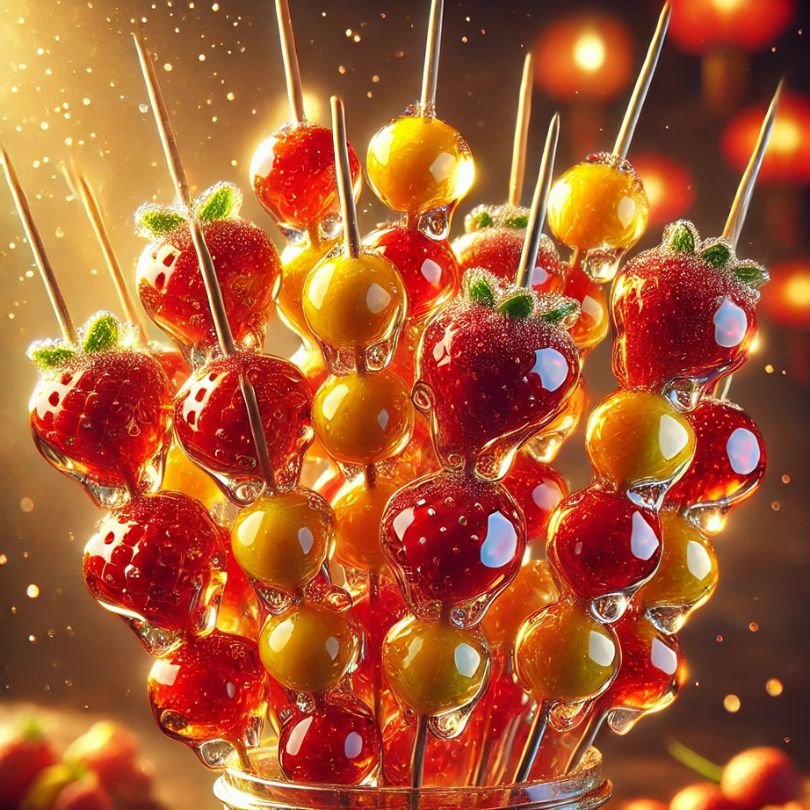Imagine gorgeous, gleaming orbs of fruit encased in a glass-like coating that shatters with a satisfying crack when you bite into it.
That’s Tanghulu. Possibly the most photogenic sweet treat you’ll ever encounter.
While it might look like something dreamed up for Instagram, this candied fruit creation has delighted people for centuries.
What is Tanghulu?
Tanghulu is a traditional Chinese sweet treat made by coating fresh fruit in a hardened sugar syrup that creates a crystalline shell.
Think of it as nature’s lollipop – fresh fruit on a stick, enrobed in a crackling candy coating that’s beautiful and delicious.
The name “tanghulu” translates rather poetically in English to “sugar bottle gourd” – though these days you’re more likely to find strawberries than gourds getting the sugar treatment.

Is Tanghulu Chinese or Korean?
While Tanghulu originated in China during the Song Dynasty (960-1279 CE), it has become deeply embedded in the food cultures of several East Asian countries.
You’ll find it as “tang hu lu” in China, “kkultaeng-i” in Korea, and “bingtanghulu” in Japan.
Each region has put its spin on the treat while maintaining the essential magic of that crackly sugar shell.
What is Tanghulu Made Of?
The beauty of Tanghulu lies in its simplicity. You only need three things:
- Fresh fruit (traditionally hawthorn berries, but strawberries, grapes, and mandarin segments are popular modern choices)
- Sugar
- Water
That’s it! Though some recipes add a splash of corn syrup to prevent crystallisation, the basic recipe hasn’t changed much in centuries.
What Does Tanghulu Taste Like?
Biting into Tanghulu is a multi-sensory experience.
First, there’s the crack – that satisfying shatter of the sugar coating. Then comes the sweetness of the hardened syrup, followed by the tartness of the fruit inside.
It’s this contrast between the brittle candy shell and juicy fruit centre that makes Tanghulu so addictive.
The best tanghulu has a perfect balance: the sugar coating should be thin enough to crack easily but thick enough to provide that characteristic crunch.
How to Make Tanghulu
Making tanghulu is equal parts science and art. Here’s how to create these crystalline beauties at home:
- Select firm, dry fruit – moisture is your enemy here
- Skewer the fruit onto bamboo sticks
- Create a sugar syrup by heating sugar and water to exactly 150°C (300°F) – the hard-crack stage
- Dip the fruit quickly into the syrup
- Allow to cool and harden
Sounds simple? Well, there’s a reason Tanghulu vendors are considered masters of their craft.
The temperature needs to be spot-on, and timing is everything.
How Do You Make Tanghulu Not Stick to Your Teeth?
Nobody wants a dental disaster! To prevent your penghulu from becoming a tooth-pulling hazard:
- Heat the sugar to the proper temperature (150°C/300°F)
- Don’t make the coating too thick
- Cool it quickly after dipping
- Store it properly (or better yet, eat it immediately!)
Is Tanghulu Healthy for You?
Let’s be real – tanghulu isn’t going to replace your daily apple. It’s a sweet treat, with all that implies.
However, compared to many other candies, it does have some redeeming qualities:
- Contains fresh fruit
- No artificial colours or flavours
- Lower fat content than many desserts
- Portion-controlled (one stick = one serving)
But remember, that sugar coating isn’t just for show – treat tanghulu as the dessert it is.
From Street Food to Social Media Star
While Tanghulu has been around for centuries, it’s currently experiencing a massive revival thanks to social media.
Videos of people biting into these glossy treats have racked up millions of views, and food creators are experimenting with everything from coffee beans to tiny cheesecakes getting the tanghulu treatment.
The appeal isn’t hard to understand – in a world of increasingly complex desserts, there’s something magical about a simple fruit transformed into an edible jewel.
Plus, that signature cracking sound makes for oddly satisfying content.
The ASMR Sensation: Why Tanghulu Sounds as Good as It Looks
The rise of Tanghulu on social media isn’t just about its jewel-like appearance – it’s about sound.
The distinctive crack of the sugar coating has made Tanghulu a star of the ASMR (Autonomous Sensory Meridian Response) world.
Videos featuring the crisp, satisfying crunch of someone biting into Tanghulu have become a subset of their own in the ASMR community.
Mukbang creators – those who film themselves eating for an audience – have particularly embraced Tanghulu.
The combination of the visual appeal, the dramatic cracking sound, and the obvious enjoyment of the treat makes for compelling content.
Some videos featuring Tanghulu have garnered millions of views, with comments sections full of people mesmerised by the sound alone.
The trend has spawned countless variations, with creators attempting to tanghulu-fy everything from cucumber slices to tiny cakes, each promising that satisfying crackle.
Some particularly creative content makers have even started experimenting with coloured sugar syrup or multiple layers of coating to create even more dramatic visual and auditory effects.
Whether you’re making it at home, hunting down a traditional vendor, or just enjoying it vicariously through your phone screen, Tanghulu offers a unique sweet experience that’s stood the test of time – and now has the Instagram likes and TikTok views to prove it.


